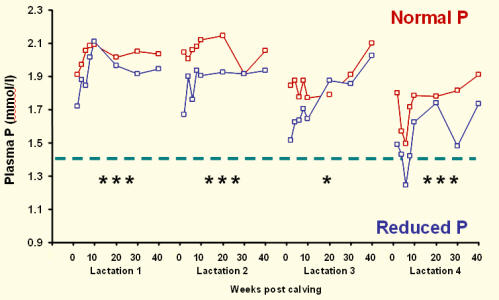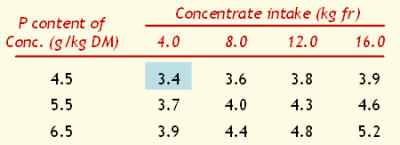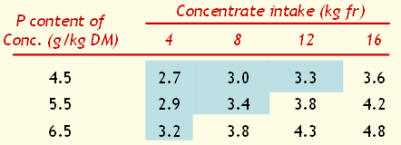



Low Phosphorus Diets
With an increasing focus on environmental issues and increasing costs, could reducing phosphate in the dairy cows diet have some benefits? TheCattleSite junior editor, Charlotte Johnston looks into the effects of low phosphate diets.Research has shown that reducing phosphate levels in animal feeds has no effect on animal performance - but why is it so important?
Recent media attention has focused around agricultural greenhouse emissions and water pollution, with the government suggesting that future subsidies will focus more and more on public goods such as environmental schemes.
Eutrophication is the polluting of waterways caused through excess nutrients in the water. This promotes growth of algae and other plant life which dissolves the oxygen content and can kill other life forms occupying the water.
Phosphorus induced eutrophication is the single thing in the UK that prevents water bodies from meeting their current targets, says Environmental Consultant, Michael Payne. However, he says that the majority of this comes through sewage, although agriculture does have a part to play.
Nutrients from agriculture enter the water primarily from surface run-off through animal manure applications.
In Northern Ireland, phosphorus regulations are in place which state that chemical phosphorus fertiliser can only be applied if a soil analysis shows the requirement. All derogated farms cannot exceed 10 kg of phosphorus per hectare per year.
Mr Payne believes that Great Britain will not adopt a regulatory approach as has been seen in Northern Ireland. A mixed approach, with more advice and support to farmers will be implemented through DEFRA, in relation to the Water Framework Directive, said Mr Payne.
Current phosphate levels
Milk production requires high phosphorus inputs. Speaking at the Nottingham Feed Conference, Conrad Ferris, Head of Dairy Research Programme at the Agri-Food and Biosciences Institute in Northern Ireland, said that agriculture is responsible for approximately 60 per cent of phosphorus entering fresh waters in Northern Ireland. This is due to the large inputs of phosphorus into animal feedstuffs and fertiliser.
Table 1 shows that in Northern Ireland nearly 19,000 tonnes of phosphorus a year are input through fertiliser and animal feedstuffs. Mr Ferris said that only 1539 tonnes (51 per cent) of the 3025 tonnes of phosphorus input leave the farm in milk. Most of what is left builds up in the soil and leaches into watercourses. It is important to note that this data is from 2000, since then the use of phosphate in fertiliser has significantly reduced.
| Table 1: Northern Ireland agricultural phosphorus balance in 2000 | |
|---|---|
| Inputs (t phosphorus/ year) | |
| Fertiliser | 9601 |
| Animal Feedstuffs | - |
| Dairy | 3025 |
| Beef | 1845 |
| Sheep | 275 |
| Pigs | 1641 |
| Poultry | 2524 |
| Total inputs | 18,911 |
Steve Brown, ruminant feeds product manager at Wynnstay, says the average recommendation for dairy cows is about 100 grams of phosphorus per cow per day. He stressed that this would vary depending on yield targets and background levels in the diet. Minerals at Wynnstay are customised for individual farms through a mineral nutrition programme. Typically Mr Brown works on 0.38- 0.4 mg of phosphorus per kg DM, but said that it is equally important to recognise that the ration of calcium phosphorus is addressed, particularly in high maize or whole crop diets.
Another leading feed manufacturer would advise 3.8 grams of phosphorus per kg DM of total diet, which would also equate to around 100 grams phosphate per cow per day.
Dairy systems have been identified as an important source of phosphorus pollution. Improved manure management practices, reducing the use of inorganic phosphorus fertiliser, reducing stocking rates, feeding less concentrates and reducing the phosphorus content of rations offered can address the problem.
Reducing the phosphorus content in dairy cow diets
Research has suggested that cows can be managed on 'reduced' phosphorus diets. Previously much of the research was based on short term studies and often not within a grassland based systems.
Mr Ferris and his team conducted a four year study into the long term effects of low phosphorus diets on dairy cows.
| Table 2: Phosphorus content of total ration (g/kg DM) | |||
|---|---|---|---|
| Normal phosphorus | Reduced phosphorus | Reduction in phosphorus (%) | |
| Winter period | - | - | - |
| Concentrates | 7.1 | 4.4 | 38% |
| Total diet | 4.8 | 3.6 | 25% |
| Summer period | - | - | - |
| Concentrates | 6.7 | 3.5 | 46% |
| Total diet | 4.2 | 3.6 | 16% |
The study compared the results of cow performance, health, fertility and bone phosphorus reserves on cows with a 'normal' phosphorus diet and those on the 'reduced' phosphorus diet. In the study phosphorus levels in total diet were reduced to 3.6 g/ kg DM on one hundred first lactation cows.
Mr Ferris showed that the changes in diet had no effect on the following:
- DM intake;
- milk yields;
- fertility;
- phosphorus reserves in bones.
Mr Ferris and his team also monitored the effect of the differing feed rations on plasma phosphorus concentration during the first four lactations. The team observed that it was not until the first 10 weeks post calving in the fourth lactation that cows experienced a deficiency in phosphorus. Figure 1 shows these results.

The study showed that liveweights were lower for cows on the reduced phosphorus diet - the differences in liveweight between the diet increased throughout the lactations as Figure 2 shows. Mr Ferris stressed that this did not affect cow performance.

How far can total dietary phosphorus levels be reduced?
Past and current research and practice suggests the following:
> 3.7 g/kg DM Over-feeding?
3.6-3.7 g/kg DM Adequate in virtually all studies
3.3-3.5 g/kg DM Occasional evidence of inadequacy
2.7-3.2 g/kg DM Adequate in some studies, inadequate in others
2.2-2.6 g/kg DM Clear evidence of deficiency
In order for phosphate to be fed accurately, phosphate quantities must be known for both concentrates and forage. While it is relatively easy to monitor the phosphate levels of concentrates, many farmers will not know the phosphate levels in their forage. Mr Ferris told the conference that the phosphorus content of grass silage can vary greatly, in a study of 200 plus silages, phosphate levels ranged between 1.6 - 4.8 g/kg DM. He recommended that farmers get the crop analysed, otherwise any changes made to concentrates may not be adequate to suit the forage phosphorus levels.
By knowing these values, when a forage has high levels of phosphorus, a concentrate with a lower phosphorus content could be adopted and vice versa.
Mr Ferris demonstrated to the group that silage with a phosphorus content of 3.0 g/kg DM could be supplemented with a phosphorus concentrate content of 4.5 g/ kg DM providing animals intake of fresh silage was 8.0 kg, which would provide total diet phosphorus of 3.6 g/kg DM. If the phosphorus content of the silage dropped to 2.0 g/kg DM and assuming the same figures as above, animals would only be receiving 3.0 g/kg phosphorus in the total diet - which risks a phosphate deficiency. Figures 3 and 4 demonstrate the different levels appropriate. Anything below 3.6 g phosphate /kg DM is viewed as a deficiency whilst 3.6g phosphate /kg DM is seen as potentially deficient.


Mr Ferris does warn that formulating low phosphate diets can be expensive. In order to formulate a low phosphate diet, ingredients such as maize gluten (a cheap-by product), which contains high values of phosphate need to be removed, however this also takes away essential sources of nitrogen. To replace this nitrogen, products like soya have to be included in the diet, which are more expensive than the cheap-by products.
The research highlighted a huge difference between phosphorus output levels when comparing the two diets. Cows on the 'normal' diet, which was contained on average 4.5 g/kg DM of phosphate, took in 103 grams of phosphorus per day and excreted 75 grams of phosphorus per day. Cattle on the 'reduced' phosphate diet took in only 72 grams per day and excreted 41 grams of phosphorus per day. This would undoubtedly lead to less phosphorus eutrophication of waterways.
Conclusion
The research carried out at the Agri-Food and Biosciences Institute has proven that the phosphorus content of dairy cow rations can be significantly reduced without a negative effect on cow performance. Mr Payne stated that the industry does need to adopt a better approach to phosphate management. Are the current phosphorus levels in feed rations excessive and creating environmental issues that if not faced now, farmers will have to face through stricter policies in coming years? Mr Ferris strongly believes that with good management and accurate rations, a low phosphorus diet can be successful.
October 2009

